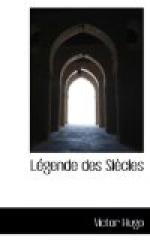he mingled fiction with his history, it was because
he conceived of the fiction as being as true a representation
of the facts of an era as annals and records.
It may be true that Hugo made imagination do duty
for study, but it is also true that an imagination,
such as Hugo’s, may be as sure an instrument
as study in reconstructing the past. He may have
mistaken the date of Crassus by several centuries,
but readers of Suetonius will hardly deny the faithfulness
of his delineation of at least one side of the civilization
of ancient Rome; he may have invented a Spanish princess,
but his carefully stippled portrait of Philip II is
true to the life, even if it be Philip in his darkest
moods. His inaccuracies are in truth of small
account. Who that reads
Le Cimetiere d’Eylau
cares whether there was a place of burial in the battlefield
or not? or what lover of
Booz endormi seeks
to know how closely the flora of Palestine has been
studied? A more serious criticism than the charge
of inaccuracy is that of partial vision, and from this
Hugo cannot be entirely exculpated. He saw with
his heart, and seeing with the heart must always mean
partial vision. For at the root of Hugo’s
nature lay an immense pity, pity not merely for the
suffering, but for what is base or criminal, or what
is ugly or degraded. It was this pity which is
the keynote of
Notre-Dame de Paris and
Les
Miserables; it is this pity which inspired much
of the
Legende des Siecles.
The defence of the weak by the strong is one of his
constant themes, as witness Eviradnus, Le
Petit Roi de Galice, Les Pauvres Gens. The
contrast of the weak and the strong is one of his favourite
artistic effects, as witness Booz endormi,
La Confiance du Marquis Falrice. An act of
pity redeemed Sultan Mourad, an act of pity made the
poor ass greater than all the philosophers. It
was this absorbing pity for the defenceless that made
Hugo so merciless to the oppressor and so incapable
of seeing anything but the deepest black in the picture
of the tyrant. One-sided the poet may be, but
it is the one-sidedness of a generous nature; he may
err, but his errors at least lean to the side of virtue.
It would be impossible in the brief space of an introduction
such as this to discuss at any length the characteristics
of Hugo as a literary artist, but a few remarks may
be made on some of the features of his art which are
most conspicuous in the poems selected for this volume.
It is scarcely necessary to dwell upon the poet’s
extraordinary fecundity of words and images.
Occasionally, especially in his later works, this
degenerates into diffuseness, and he exhibits a tendency
to repetition and a fondness for long enumeration
of names and details. On the other hand, he constantly
shows how well he understood the power of brevity
and compression. There is not a superfluous word
nor a poetic image in La Conscience, the severe




